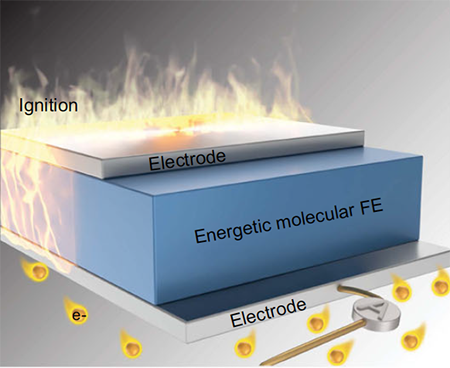| Oct 14, 2021 | |
Energetic ferroelectrics |
|
| (Nanowerk Spotlight) Chemical energy is a term for the energy stored in the covalent bonds that are holding atoms together in the form of molecules. So-called energetic materials store a large amount of chemical energy that can be converted into mechanical energy. | |
| Energetic materials in the form of molecular crystals constructed by the C–N, N–N, and N–O bonds store chemical energy, while their strong electron–phonon coupling interactions promise high-energy density through thermal waves. At the same time, symmetry breaking in molecular crystals induces self-polarization and electron–phonon interaction, leading to molecular ferroelectrics. | |
| A research team from the University at Buffalo, the University of Maryland, and the U.S. Army Research Laboratory, wanted to know if these two dissimilar materials – molecular energetic materials and ferroelectrics – can somehow be combined to obtain a chemically driven electrical energy source with high-power density. Such a power source could potentially be employed for on-demand energy sources, propulsion, or thermal batteries. | |
| In a paper in Nature Communications ("Chemically driven energetic molecular ferroelectrics"), they report that two dissimilar materials, molecular energetic materials and ferroelectrics, can be integrated together to obtain chemically driven electrical energy with a high specific power of 1.8 kW/kg and achieve an estimated detonation velocity of 7.20 ± 0.27 km/s, comparable to trinitrotoluene (TNT) and hexanitrostilbene (HNS). | |
| The team reports in their paper that a large thermal and shock wave from energetic compound decomposition results in a fast electrical energy release due to the pyroelectric effect in molecular ferroelectrics. This study reveals that this chemically driven energy generator is a result of the coupling between energetic thermal and shock waves and a pyroelectric effect in molecular ferroelectrics. | |
| The researchers also point out that the polarization of molecular energetic ferroelectrics can control the energy density and energy release rate of the available chemical energy. | |
| This work demonstrates the design of energetic molecular ferroelectrics consisting of imidazolium cations and perchlorate anions, showing a high-power density comparable to Li-ion batteries. | |
 |
|
| Schematic figure for electricity generation in energetic molecular ferroelectrics (FE). (Reprinted with permission from Yong et al., Nat. Commun. 12, 5696 (2021). Copyright 2021 Author(s), licensed under a Creative Commons Attribution 4.0) | |
| In their paper, the team details three key findings: | |
| 1) The energetic property and spontaneous polarization are integrated in a molecular crystal by a delicate design. The energetic molecular ferroelectrics releases a large thermal energy of 3810.6 kJ/kg and a large pyroelectric coefficient of -6,334 µC m−2 K−1. | |
| 2) An estimated detonation velocity of 7.20 ± 0.27 km/s based on a characteristic laser-induced shock velocity of 740.0 ± 11.1 m/s is obtained, which is comparable to TNT and HNS. A large thermal and shock wave from energetic compound decomposition results in a fast electrical energy release with a high power density up to 1.8 kW kg−1 due to the pyroelectric effect in molecular ferroelectrics; | |
| 3) Theoretical calculations reveal the role of electron-phonon interaction in tuning the energy density of energetic molecular ferroelectrics. | |
| In a next step, the scientists plan to adopt machine learning to explore more energetic molecular ferroelectrics. They also will attempt to further improve the energetic performance and energy conversion power through chemical engineering. | |
| The results obtained in this work are based on a small device scale in the nanometer and micrometer range. However, for practical applications, this chemically driven electricity generation needs to be realized in large, low-cost devices. | |
| In conclusion, integrating molecular ferroelectric and energetic molecules is a promising strategy for emerging energy applications demanding high power density. | |
 By
Michael
Berger
– Michael is author of three books by the Royal Society of Chemistry:
Nano-Society: Pushing the Boundaries of Technology,
Nanotechnology: The Future is Tiny, and
Nanoengineering: The Skills and Tools Making Technology Invisible
Copyright ©
Nanowerk LLC
By
Michael
Berger
– Michael is author of three books by the Royal Society of Chemistry:
Nano-Society: Pushing the Boundaries of Technology,
Nanotechnology: The Future is Tiny, and
Nanoengineering: The Skills and Tools Making Technology Invisible
Copyright ©
Nanowerk LLC
|
|
|
Become a Spotlight guest author! Join our large and growing group of guest contributors. Have you just published a scientific paper or have other exciting developments to share with the nanotechnology community? Here is how to publish on nanowerk.com. |
|
